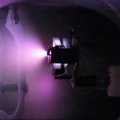 Hi everyone, welcome to the Hack Chat. Today we're excited to welcome Michael Bretti of Applied Ion Systems to the Hack Chat. He's literally building the future - open-source thrusters for DIY satellites that you'll be able to buy off-the-shelf someday!
Hi everyone, welcome to the Hack Chat. Today we're excited to welcome Michael Bretti of Applied Ion Systems to the Hack Chat. He's literally building the future - open-source thrusters for DIY satellites that you'll be able to buy off-the-shelf someday!
Welcome Michael - can you tell us a little about how you got to this point?
 Thanks Dan! Like Dan mentioned, I am currently leading development of open source propulsion for small satellites. As far as I am aware, this is really the first and only fully open source propulsion program out there. I have a small, modular high vacuum system for testing these systems. Details are archived on my website here: http://appliedionsystems.com/
Thanks Dan! Like Dan mentioned, I am currently leading development of open source propulsion for small satellites. As far as I am aware, this is really the first and only fully open source propulsion program out there. I have a small, modular high vacuum system for testing these systems. Details are archived on my website here: http://appliedionsystems.com/
 Other media and references can be seen on twitter and Instagram as well: https://twitter.com/Applied_Ion
Other media and references can be seen on twitter and Instagram as well: https://twitter.com/Applied_Ion

https://www.instagram.com/appliedionsystems/
Login * Instagram
Welcome back to Instagram. Sign in to check out what your friends, family & interests have been capturing & sharing around the world.
 Currently, I have 2 thrusters slated for space this upcoming year with AMSAT-Spain's GENESIS PocketQubes
Currently, I have 2 thrusters slated for space this upcoming year with AMSAT-Spain's GENESIS PocketQubes
 Lot's of new and exciting collaborations to come with others in the community though!
Lot's of new and exciting collaborations to come with others in the community though!
 I was just going to ask when you expect to fly hardware. That's really exciting!
I was just going to ask when you expect to fly hardware. That's really exciting!
 I have primarily been focusing on pulsed plasma thrusters, but have recently switched gears for more advanced systems such as ionic liquid ion source (ILIS) thrusters
I have primarily been focusing on pulsed plasma thrusters, but have recently switched gears for more advanced systems such as ionic liquid ion source (ILIS) thrusters
 Yeah, it should be sometime early 2020, assuming they pass integration and environmental testing
Yeah, it should be sometime early 2020, assuming they pass integration and environmental testing
 What is the primary power source?
What is the primary power source?
 For the PPT that is being launched, the AIS-gPPT3-1C, it is designed to run from 3.3V to 4V power from the PQ battery bus
For the PPT that is being launched, the AIS-gPPT3-1C, it is designed to run from 3.3V to 4V power from the PQ battery bus
 the circuit boosts this to about 1kV for the primary bank, and a pulse transformer provides a 10kv trigger pulse for ignition
the circuit boosts this to about 1kV for the primary bank, and a pulse transformer provides a 10kv trigger pulse for ignition
 Ill post the circuit here
Ill post the circuit here
 Solar panels feeding the batteries?
Solar panels feeding the batteries?


 Yeah
Yeah
 Can private groups use radio-isotopes yet?
Can private groups use radio-isotopes yet?
 I highly doubt it, dealing with any radioactive sources would be a nightmare to deal with
I highly doubt it, dealing with any radioactive sources would be a nightmare to deal with
 No need though, the groups out there are using quite high efficiency cells, and lots of exciting development for deployable arrays to really boost power capabiities
No need though, the groups out there are using quite high efficiency cells, and lots of exciting development for deployable arrays to really boost power capabiities
 What type of fuel are you looking to use with the ILIS engine?
What type of fuel are you looking to use with the ILIS engine?
 Plus I think the government has a pretty tight lid on plutonium-238 supply. They've got pretty much the world supply sitting in the RTGs that will go to Mars with the Mars Rover mission.
Plus I think the government has a pretty tight lid on plutonium-238 supply. They've got pretty much the world supply sitting in the RTGs that will go to Mars with the Mars Rover mission.
 I will be using standard EMI-BF4, a popular room temperature ionic molten salt. Very well studied and understood, and highly stable
I will be using standard EMI-BF4, a popular room temperature ionic molten salt. Very well studied and understood, and highly stable
 Pardon me for interrupting. What kinds of packages are people talking about sending?
Pardon me for interrupting. What kinds of packages are people talking about sending?
 Weren't plasma thrusters first used in 1964? What kind of innovation or improvement has this now?
Weren't plasma thrusters first used in 1964? What kind of innovation or improvement has this now?
 Electric propulsion (EP) in general dates back to the 60s. The thrusters built back then were monstrous though, huge beasts 10s to 100s of kW of power. The key difficulty in EP has been scaling down.
Electric propulsion (EP) in general dates back to the 60s. The thrusters built back then were monstrous though, huge beasts 10s to 100s of kW of power. The key difficulty in EP has been scaling down.
 Curently, there is no EP solution on the market for PQs
Curently, there is no EP solution on the market for PQs
 there is a lot of competition at the cubesat level, but it is still very costly
there is a lot of competition at the cubesat level, but it is still very costly
 My goal is to radically bring down price, and scale to a level that is very accessible to low funded groups, as well as provide resources on these thrusters showing how I go through designing and building them, from concept to deployable solution
My goal is to radically bring down price, and scale to a level that is very accessible to low funded groups, as well as provide resources on these thrusters showing how I go through designing and building them, from concept to deployable solution
 Cool
Cool
 EP right now is highly protected, open source EP is unheard of in industry
EP right now is highly protected, open source EP is unheard of in industry
 lots of details in academia, but published data or experiments is not quite the same as open source
lots of details in academia, but published data or experiments is not quite the same as open source
 Have you gotten any pushback from the industry for disrupting things?
Have you gotten any pushback from the industry for disrupting things?
 and most of it is just experimental benchtop systems
and most of it is just experimental benchtop systems
 How far along are you with the ILIS thruster?
How far along are you with the ILIS thruster?
 No not yet! But I am sure once i get the ILIS thruster running, I may make some enemies
No not yet! But I am sure once i get the ILIS thruster running, I may make some enemies
 I have the design just about ready to go for first prototypes, just waiting on machining quote for the porous glass emitter
I have the design just about ready to go for first prototypes, just waiting on machining quote for the porous glass emitter
 hopefully I'll have that quote today or tomorrow, which is the key driving cost for this thruster at this point
hopefully I'll have that quote today or tomorrow, which is the key driving cost for this thruster at this point
 Be sure to patent your work.
Be sure to patent your work.
 since it relies on standard CNC vs traditional micromachining, it allows ILIS thrusters to actually be accessible at this level
since it relies on standard CNC vs traditional micromachining, it allows ILIS thrusters to actually be accessible at this level
 I've heard everyone saying to patent stuff
I've heard everyone saying to patent stuff
 cant afford patents lol
cant afford patents lol
 You seem to have devoted a lot of resources to the solid-fuel thrusters. Why the switch to liquid fuel?
You seem to have devoted a lot of resources to the solid-fuel thrusters. Why the switch to liquid fuel?
 It will cost you dude.
It will cost you dude.
 my budget is practiclly non-existant
my budget is practiclly non-existant
 Patents are just permission slips to be sued.
Patents are just permission slips to be sued.
 That's a nice way of putting it.
That's a nice way of putting it.
 You can always start a Gofundme campaign or use crowdfunding.
You can always start a Gofundme campaign or use crowdfunding.
 While solid PPT thrusters are great leaning tools, the physics just don't allow it to scale for the thrust needed at the power restrictions of a PQ. Hpwever, ILIS has extraordinary potential, in that it can provide very high thrust to power ratios at very high efficiency and ISP. This type of thruster also eliminates the need for any pressurized feed, valves, active flow control, heaters, or electron emitting neutralizer
While solid PPT thrusters are great leaning tools, the physics just don't allow it to scale for the thrust needed at the power restrictions of a PQ. Hpwever, ILIS has extraordinary potential, in that it can provide very high thrust to power ratios at very high efficiency and ISP. This type of thruster also eliminates the need for any pressurized feed, valves, active flow control, heaters, or electron emitting neutralizer
 Yeah, but its the only protection you have. Licensing, especially public licensing isnt worth a damn. Just sayin lol.
Yeah, but its the only protection you have. Licensing, especially public licensing isnt worth a damn. Just sayin lol.
 Hi! Excuse me. I am new in the topic. How many key pieces is a thruster comprised of?
Hi! Excuse me. I am new in the topic. How many key pieces is a thruster comprised of?
Patents: If it is published anywhere, then it is not patentable anymore. Otherwise, you can afford $120 for the provisional that is good for a year, enough time to get some funding for the whole thing including patents. But then it is not open source anymore ^^
 Now THAT'S a Kickstarter I could back!
Now THAT'S a Kickstarter I could back!
 Ditto
Ditto
 @toani it depends on the thruster and the scale, it's hard to say unless we are talking about a specific system
@toani it depends on the thruster and the scale, it's hard to say unless we are talking about a specific system
 hello
hello
 from what I have seen full tech patents in the US can average around $20k
from what I have seen full tech patents in the US can average around $20k
 I see thanks
I see thanks
 Patent == patent attornies == billable hours
Patent == patent attornies == billable hours
 As an individual doing this out of pocket in my free time, patents are out of the question
As an individual doing this out of pocket in my free time, patents are out of the question
 Business is business.
Business is business.
Anyway, rocket science ;-)
 Can the ILIS thrusters be used in heavy spaceships? Like say Falcon 9 which uses liquid oxygen as its primary fuel?
Can the ILIS thrusters be used in heavy spaceships? Like say Falcon 9 which uses liquid oxygen as its primary fuel?
 but I will say that doing this type of work at a highly restricted budget has pushed me to think way outside the box and really simplify these systems
but I will say that doing this type of work at a highly restricted budget has pushed me to think way outside the box and really simplify these systems
 @yashelite how do you define heavy?
@yashelite how do you define heavy?
![]() I would continue with the open source and publish it at a few places to make sure your rights are recognized
I would continue with the open source and publish it at a few places to make sure your rights are recognized
 like very large satellites?
like very large satellites?
 Have you done any RF and optical evaluation yet? These types of electric propulsion systems are effectively spark gap transmitters that emit damped radio waves (bad) as well as ultra-violet emissions which can interfere with ground-based astronomical observations. To my knowledge these have only flown with experimental designation where these concerns could be coordinated accordingly.
Have you done any RF and optical evaluation yet? These types of electric propulsion systems are effectively spark gap transmitters that emit damped radio waves (bad) as well as ultra-violet emissions which can interfere with ground-based astronomical observations. To my knowledge these have only flown with experimental designation where these concerns could be coordinated accordingly.
 @Nicolas Tremblay yeah, at this point I publish details and updates regularly on Twitter, and archive stuff on the website
@Nicolas Tremblay yeah, at this point I publish details and updates regularly on Twitter, and archive stuff on the website
 By heavy I mean spaceships which can carry a substantial amount of payload.
By heavy I mean spaceships which can carry a substantial amount of payload.
 @Ethan Waldo for ILIS no need - as a DC thruster it outputs no RF interference, and optically the emission is very light to negligeable. The PPTs can generate a bunch of noise due to the pulse, but they are the oldest and some of the most commonly flown and tested EP
@Ethan Waldo for ILIS no need - as a DC thruster it outputs no RF interference, and optically the emission is very light to negligeable. The PPTs can generate a bunch of noise due to the pulse, but they are the oldest and some of the most commonly flown and tested EP
 PPTs especially due to their extreme simplicity, low cost, and ruggedness
PPTs especially due to their extreme simplicity, low cost, and ruggedness
 Not the PPT, but the actual sparks between anode and cathode is what generates bad emissions
Not the PPT, but the actual sparks between anode and cathode is what generates bad emissions
 @yashelite technically it could scale, but I think at a certain point the big ion or plasma engines would take over - efficiency and performance goes up with these at higher power levels, and ILIS is not at the point yet for massive array scaling
@yashelite technically it could scale, but I think at a certain point the big ion or plasma engines would take over - efficiency and performance goes up with these at higher power levels, and ILIS is not at the point yet for massive array scaling
 Just like a spark plug
Just like a spark plug
 @Ethan Waldo the PPT produces a spark - one for ignition, and the main plasma pulse. If the ILIS thruster sparks, then it can damage the thruster lol.
@Ethan Waldo the PPT produces a spark - one for ignition, and the main plasma pulse. If the ILIS thruster sparks, then it can damage the thruster lol.
 So, orbital dynamics newbie here, maybe a dumb question. How do you get the thrust from one of these pointed in the right direction? IOW, how are PocketQubes able to control their attitude relative to the direction of orbit?
So, orbital dynamics newbie here, maybe a dumb question. How do you get the thrust from one of these pointed in the right direction? IOW, how are PocketQubes able to control their attitude relative to the direction of orbit?
 The main discharge for a PPT can range from several hundreds to thousands of amps in a few uS
The main discharge for a PPT can range from several hundreds to thousands of amps in a few uS
 @Dan Maloney great question! That's another task that needs to be addressed at the PQ level - attitude control. It's either you have none and tumble freely, have passive means like magnetorquers, or active control like reaction wheels
@Dan Maloney great question! That's another task that needs to be addressed at the PQ level - attitude control. It's either you have none and tumble freely, have passive means like magnetorquers, or active control like reaction wheels
 yes, I would highly recommend an evaluation and publish results
yes, I would highly recommend an evaluation and publish results
 Most PQs have some form of passive control
Most PQs have some form of passive control
 active control is a challenge due to power and size constraints, but there are a few out there actively working on this
active control is a challenge due to power and size constraints, but there are a few out there actively working on this
 I think I saw something about PQs having permanent magnets on board to keep them aligned to the earth's magnetic field. Is that magnetotorque?
I think I saw something about PQs having permanent magnets on board to keep them aligned to the earth's magnetic field. Is that magnetotorque?
 Hi, Jonny from Sweden in China.
Hi, Jonny from Sweden in China.
How do you switch a couple of thousands of Amps?
 So for the GENESIS satellite, the plan will be firing when it is passively aligned in the correct direction. So a period of about 15 minutes every 90 minute orbit
So for the GENESIS satellite, the plan will be firing when it is passively aligned in the correct direction. So a period of about 15 minutes every 90 minute orbit
 @Dan Maloney yes that's correct
@Dan Maloney yes that's correct
 @Jonny Wester no need to switch that current. The trigger pulse is a low current, high voltage pulse that ablates an initial amount of fuel between the cathode and igniter. This inital ionized fuel then allows for a conducting path to be formed between the anode and cathode, which a larger cap bank is charged and connected to. This energy gets directly dumped in, ablating more fuel, ionizing, and accelerating it as the plasma you see out the end.
@Jonny Wester no need to switch that current. The trigger pulse is a low current, high voltage pulse that ablates an initial amount of fuel between the cathode and igniter. This inital ionized fuel then allows for a conducting path to be formed between the anode and cathode, which a larger cap bank is charged and connected to. This energy gets directly dumped in, ablating more fuel, ionizing, and accelerating it as the plasma you see out the end.
 So it acts essentially as a triggered spark gap switch
So it acts essentially as a triggered spark gap switch
 albeit a bit different
albeit a bit different
 (since triggered gaps don't rely on ablated ionized fuel for firing)
(since triggered gaps don't rely on ablated ionized fuel for firing)
 and the plasma only works in a high enough vacuum :)
and the plasma only works in a high enough vacuum :)
 here is a video of the thruster firing:
here is a video of the thruster firing:

https://www.youtube.com/watch?v=sXPIOc-TzTk
 yeah, these thrusters require vacuum to operate correctly
yeah, these thrusters require vacuum to operate correctly
 Capacitor banks, I have had dreams about this!!! Now they are real. So, creating plasma as a thruster.
Capacitor banks, I have had dreams about this!!! Now they are real. So, creating plasma as a thruster.
 differnet types of thrusters have different types of vacuum testeing requirements
differnet types of thrusters have different types of vacuum testeing requirements
 You might have to find several projects in development phase, then offer to design their propulsion subsytem. Ask for attitude data and methods for controlling orientation. If you can have multiple small units of yours - for each axis or primary direction, then you can write the control algorithms and model them.
You might have to find several projects in development phase, then offer to design their propulsion subsytem. Ask for attitude data and methods for controlling orientation. If you can have multiple small units of yours - for each axis or primary direction, then you can write the control algorithms and model them.
The earliest plasma experiments were modified spark gaps where the ionization was provided by external sources - beta or alpha emitters, uv sources, electron beams, smaller ion and electron sources.
 Yeah, one of my main specialties, pulsed power, deals a lot with this in history. Dumping huge banks of energy into plasma or pulsed particle beam systems
Yeah, one of my main specialties, pulsed power, deals a lot with this in history. Dumping huge banks of energy into plasma or pulsed particle beam systems
 Dates very early on back to the 50s
Dates very early on back to the 50s
 Yes, massive pulsed capacitor banks, and "spark plugs", genious!
Yes, massive pulsed capacitor banks, and "spark plugs", genious!
 That was the golden age of space exploration and propulsion systems.
That was the golden age of space exploration and propulsion systems.
 @RichardCollins yeah, I'm actively collaborating with several groups
@RichardCollins yeah, I'm actively collaborating with several groups
 Now there are supercapacitors.
Now there are supercapacitors.
 Actually, spark gap switches are still to king of switching. Some of the state of the art stuff is really wild
Actually, spark gap switches are still to king of switching. Some of the state of the art stuff is really wild
 at least in pulsed power they are a very dominant form of switching
at least in pulsed power they are a very dominant form of switching
![]() What kind of facilities/equipment did it take to get to this stage? Have you done it all in your own shop / rented time / outsourced?
What kind of facilities/equipment did it take to get to this stage? Have you done it all in your own shop / rented time / outsourced?
 It would interfere seriously with the electronics in the close vincinity controlling it. How to protect the control circuitry from thus massive EMC?
It would interfere seriously with the electronics in the close vincinity controlling it. How to protect the control circuitry from thus massive EMC?
 @Bob the biggest requirement is high vacuum. This was all designed and optimied from scratch with available surplus. In the US at least, it is very easy to get vacuum equipemnt on ebay, however there is a whole group of vacuum enthusiasts around the world. if you are interested, I would check out the Vacuum Hackers discord chat. Fantastic place with tons of awesome high vacuum projects around the world. A lot of the design resources were free that I used - fusion 360 for CAD and thermal (CAD is a must for planning!), and a free vacuum simulation software from CERN called MOLFLOW+ (but this is highly overkill for most amaetur vacuum work). Really, it comes down to a lot of prep. I spent a year prior collecting resources, data, and getting preppped before designing my system so it would just work when switched on.
@Bob the biggest requirement is high vacuum. This was all designed and optimied from scratch with available surplus. In the US at least, it is very easy to get vacuum equipemnt on ebay, however there is a whole group of vacuum enthusiasts around the world. if you are interested, I would check out the Vacuum Hackers discord chat. Fantastic place with tons of awesome high vacuum projects around the world. A lot of the design resources were free that I used - fusion 360 for CAD and thermal (CAD is a must for planning!), and a free vacuum simulation software from CERN called MOLFLOW+ (but this is highly overkill for most amaetur vacuum work). Really, it comes down to a lot of prep. I spent a year prior collecting resources, data, and getting preppped before designing my system so it would just work when switched on.
 For vacuum, I can reach in the 10^-6 torr range. I optimized my system for high pumping speed based off of 6" conflat hardware, which is pretty available, and not too bad in cost used, and is a good balance between size and cost for what I need
For vacuum, I can reach in the 10^-6 torr range. I optimized my system for high pumping speed based off of 6" conflat hardware, which is pretty available, and not too bad in cost used, and is a good balance between size and cost for what I need
![]() That is really impressive! Helpful information, too. Thank you. I just spotted this project when it was featured on HaD but I'm pretty much glued to it now.
That is really impressive! Helpful information, too. Thank you. I just spotted this project when it was featured on HaD but I'm pretty much glued to it now.

 Lutetium
Lutetium
Discussions
Become a Hackaday.io Member
Create an account to leave a comment. Already have an account? Log In.